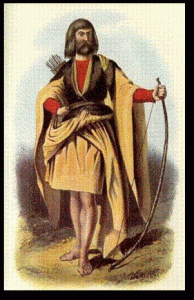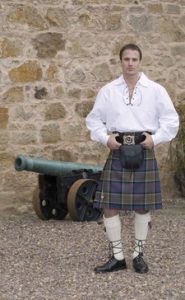Since my mother’s dna is largely Scottish – 37% Highland Scots (Irish and Scandinavian dna), 56% lowland Scots, aka Scotch-Irish (a mishmash of Picts, Gauls, Saxons, and Anglos), and that mystery 6% thrown in for fun – I’ve been studying my Scottish history and have learned that most of what we assume to be Scottish isn’t!
- The kilt, as we know it, was invented in 1730 by Thomas Rawlinson, an Englishman from Lancashire. He had an iron-ore smelting business in Inverness, Scotland. The men who worked there wore the traditional “great kilt,” a long piece of cloth wrapped sort of like a sari and belted around the waist, with the extra length draped over the shoulder. It was a fire hazard, so he hired a tailor to design something safer for industrial work. So the short kilt (skirt separated from top wrap) was born and became ubiquitous. So highlanders would have dressed more like this….

- I also learned there were no distinct clan tartans. Early descriptions of Highland dress describe the men wearing wraps or cloaks of varying shades of brown, which blended in well with the heather so would be better for hunting or battle. The chieftain’s clothing was distinguished by being dyed bright with saffron. The “tartan” – which was simply a cloth woven in a geometric patterns including stripes – appeared later, and was associated with districts and weavers rather than with particular clans. Specific clan tartans did not exist until the 19th century and came about through a hoax. Two brothers from Surrey fabricated an “ancient” book they called the Vestiarium Scotium creating Tartans and assigning each to a clan. This hoax book was republished in various forms and then taken up by Scottish cloth manufacturers.
- Finally, my lowland Scots ancestors, who lived on the border of Scotland and England, were generally considered to be thieving scum. Many were “reavers,” or cattle thieves. The reavers raided both sides of the border with impunity and made life there unstable and passage through it dangerous. James I, who first unified England and Scotland, moved these troublesome lowland Scots to Ireland thereby solving two political problems at once; he pacified the border and established a bulkhead for colonization in Ireland.
So my highland ancestors were really Irish who sailed to the Scottish coast, mixed with Vikings, and didn’t wear kilts of have specific tartans. While my lowland Scottish ancestors were cattle thieves. Thereby further proving my belief that if you want to admire your ancestors, it’s best not to research them too deeply!


I have no idea whether my lowland Scots ancestors were reivers or not, but we should not be too hasty to judge old ways of living by today’s “civilized” standards. Reiving, although sometimes violent, was a way to make a living. Some of my family originated in Ayrshire, which seems pretty distant from the border of England. What I do know is that at least some ancestors on both my father’s and mother’s side were Covenanters, and continued to be through the years in Ulster and later in Pennsylvania. The Covenanters were despised and persecuted, and the removal of them by James VI (aka James I) might be seen as a favor to them. For James, it solved the same problem he had with the reivers. Many Scotsmen also hired out as mercenaries in the continental armies. It might be argued that the fighting skills learned from being reivers made the Scotch-Irish particularly well equipped to conditions on the American frontier, where they were encouraged to settle as a buffer against the Indians, as well as for later service on behalf of the American Revolution.
Hugh, The Border Reivers became cattle thieves and land pirates in response to warring armies repeatedly crossing their lands and decimating their crops, homes, and livestock. I don’t judge them. My mother’s family was very elegant and well-to-do and imagined – with no basis – that their forbearers were lords and ladies, so it amuses and delights me to discover that their/our ancestors were thieves.
There are specific names associated with the Reivers. If you’d like to find out if your ancestors were among them (several of my ancestral lines are), this is a good source:
http://www.electricscotland.com/history/other/border_reivers3.htm